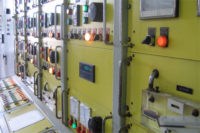
Recently, AJ Naber, Dorner Manufacturing senior design engineer, designed a retractable-tail metal detection conveyor for a frozen French fry manufacturer. “Based on the configuration of the existing processing line, a retractable conveyor was the best fit for this application,” says Naber. The conveyor primarily runs in the extended position, and as French fries successfully pass through the metal detector, they continue on the extended conveyor to a take-away conveyor. When the metal detection system detects metal within the flow of French fries, the retractable-tail conveyor pulls back and creates a gap to allow the product to fall onto a second conveyor for disposal, adds Naber.
While this was a fairly complex application, others can range from a basic stop-on-detect-requiring operator intervention-to varying degrees of complexity, says Naber. Stop-on-detect is the simplest and generally least expensive option available.
Nevertheless, many processing lines need more automation, which requires some type of reject mechanism beyond human intervention. Push-on-detect, air blast and diverter arms are some of the common reject mechanisms on metal detection conveyor systems, says Naber.
- Push-on-detect involves a pusher mechanism mounted to the side of the conveyor. The pusher face is actuated when the metal detector flags a product for rejection.
- Air blast operates similarly to push-on-detect. However, rather than a pusher, a flagged product is removed from the conveyor by a blast of air. This works with lightweight products requiring a more finite reject.
- Suited for bulk materials, a diverter arm swings out across the width of the conveyor belt to guide flagged product to a reject lane or bin for disposal.
The area within the metal detector through which product travels is known as the aperture. Within the aperture there needs to be room to accommodate both the conveyor and the product, says Naber. Most metal detectors require a metal-free zone of approximately 1.5 times the aperture height. This constraint presents a challenge because everything on the conveyor system within this metal-free zone needs to be made from plastic.
The stainless steel conveyor frame also needs to be split to run plastic through the aperture and within the metal-free zone. “That’s why it’s important to properly size a metal detection system to the application,” advises Naber. “I recommend considering all supporting equipment including the conveyors and reject method when selecting a metal detector for a processing line. Think of the metal detector and supporting conveyor line as one integrated component.”
Selecting a metal detector with an aperture that may be too big for the product may also limit space where accessories can be mounted to the conveyor frame. “Remember, a larger aperture casts a larger metal-free zone around the entire system,” says Naber. And if the metal detection system is located in a fairly confined space, available space on the frame to mount the reject mechanisms may be limited. From an engineering standpoint, it’s always a challenge to make the system as sanitary and compact as possible while still achieving what the application requires.
“Ultimately any design we make needs to be safe, and often, safety and sanitation don’t go hand in hand. Ideally we want as little human intervention in the reject mechanisms as possible, so we’ll add various guards to eliminate access to dangerous areas. However, with every component that is added to the conveyor, you can decrease its overall level of sanitation,” says Naber. “It’s a balancing act. Our job is to design a metal detection conveyor system that’s very sleek, smooth and uninterrupted, but at the same time provides the highest level of safety.”
No two metal detection conveyor systems are identical. However, when specified properly, they can serve an integral role toward adding value and efficiency to any production line.
For more information, contact AJ Naber, Dorner Manufacturing, 262-369-1258.

